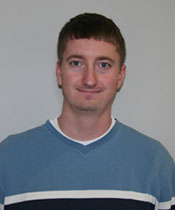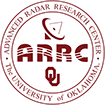Current Students
Brandon Cohen (M.S.)
Future operational phased array radars (PARs) will be able to scan tornadic and nontornadic storms much faster than existing systems with many diverse scanning modes. Brandon is exploring how a future operational PAR can use these modes to distinguish between tornadic and nontornadic storms.
Rachael Cross (M.S.)
Rachael is studying characteristics of tornado debris signatures (TDSs) using SimRadar, examining how TDS characteristics change for 1) different types, sizes, and concentrations of debris and 2) different tornado wind speed intensities and tornado flow structures.
Sam Emmerson (M.S.)
Sam is using a new type of radar technology within the atmospheric sciences called passive radar. Passive radars are a type of bistatic radar used to retrieve Doppler velocities and construct 3D winds. Currently, we are using these passive radars with NEXRADs and will soon use them with our mobile radars too.
Connor Pearson (M.S.)
Future phased array radars (PARs) offer a wide range of capabilities to scan adaptively and much faster. Connor is using radar simulations to examine how a future operational PAR network and its unique scanning modes can observe and better predict microbursts.
Morgan Schneider (M.S.)
Morgan is exploring how tornado debris affect radar-based wind speed estimation using SimRadar and mobile radar observations. She is developing techniques to estimate and correct Doppler velocity errors caused by debris centrifuging.
Laura Shedd (M.S.)
Hailstorms cause billions of dollars in damage each year. Laura is studying how combining dual-polarization radar signatures of hail with rapid-scan radar observations can lead to a better understanding of hail formation and different patterns of hail fallout (e.g., sizes and concentrations).
Min-Duan Tzeng (Ph.D.)
Three-dimensional winds are critical to atmospheric science research, from understanding tornadogenesis to more general studies of convective updraft characteristics. Min-Duan is integrating open-source dual-Doppler software with the ARRC's mobile radars to provide real-time 3D wind retrievals.
Past Students
Clarice Dyson (M.S.; Completed 2019)
Thesis: Multi-Radar Analysis of the 20 May 2013 Moore, Oklahoma Supercell Through Tornadogenesis and Intensification (link)
Casey Griffin (Ph.D.; Completed 2019)
Dissertation: Polarimetric and Rapid-Scan Observations of Tornadoes (link)
Andrew Mahre (Ph.D.; Completed 2020)
Dissertation: Quantitative Analysis of Rapid-Scan Phased Array Weather Radar Benefits and Data Quality Under Various Scan Conditions (link)
Martin Satrio (M.S.; Completed 2019)
Thesis: The Effects of Terrain on an Idealized Tornado using a Large-Eddy Simulation (link)


